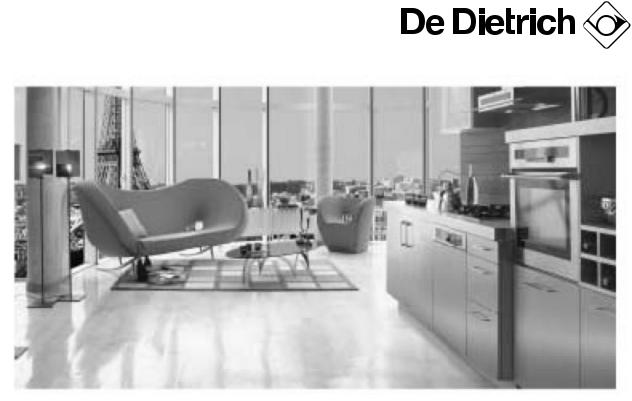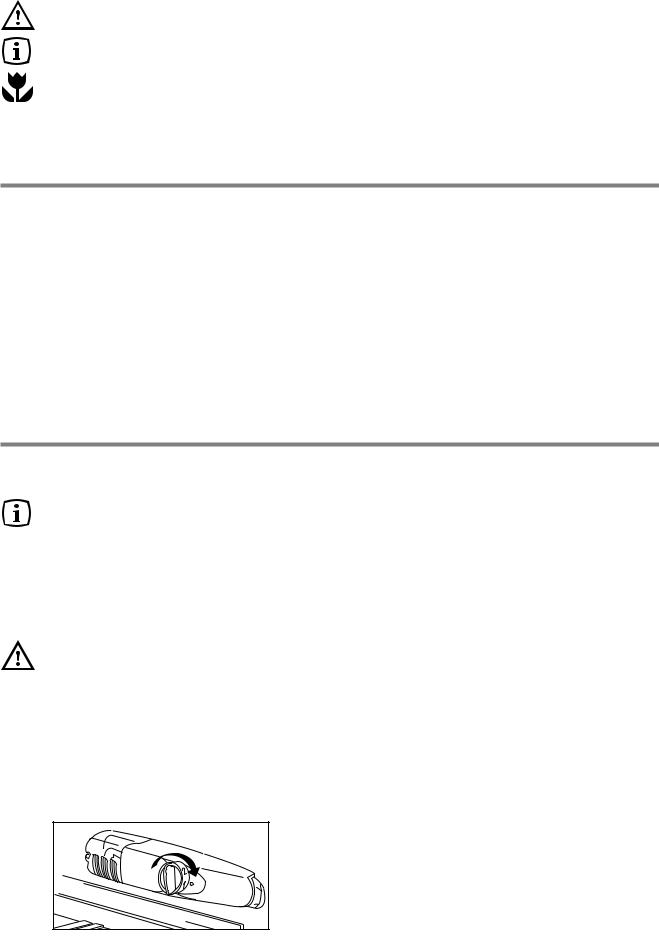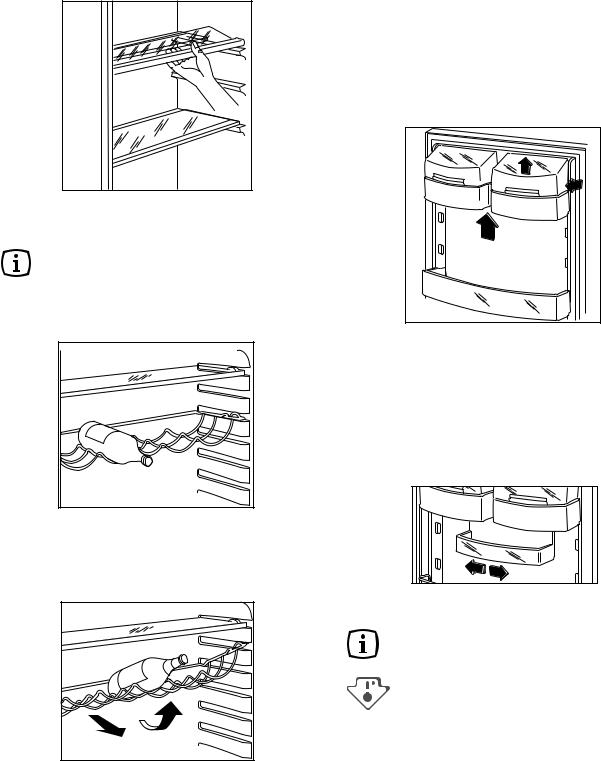DE DIETRICH DRS722JE User Manual

F R GUIDE D’INSTALLATION & D’UTILISATION E N INSTRUCTIONS FOR USE
N L GEBRUIKS AANWIJZING
D E BEDIENUNGSANLEITUNG
E S MANUAL DE INSTRUCCIONES P T MANUAL DE INSTRUCOES
I T MANUALE DI ISTRUZIONI
Réfrigérateur
Refrigerator
Ijkast
Kühlschrank
Frigorifico
Frigorífico
Frigorifero
2222722-26

Safety Instructions |
t |
|
|
|
|
These warnings are provided in the interests of your safety. Please read these operating instructions carefully before installing the appliance. Ensure you fully understand them before installing or using the appliance. If you are unsure about the meaning of these warnings contact the Customer Care Department.
Domestic Use
•The domestic refrigerators and freezers are designed to be used specifically for the storage of edible foodstuffs only.
•Check the appliance for transport damage. Under no circumstances should a damaged appliance be installed. In the event of damage please contact your retailer.
•This appliance is heavy. The edges and projecting parts of the cabinet may be sharp. Be careful when moving the cabinet and always use gloves.
•Any electrical work required to install this appliance should be carried out by a qualified electrician or competent person.
•Ensure that the appliance does not stand on the electrical supply cable.
•Do not use electrical appliances inside the appliance
•Do not keep carbonated drinks or bottles in the freezer compartment. The glass bottles may break.
•Ice lollies can cause ‘frost/freezer burns’ if consumed straight from the freezer.
•It is dangerous to try and alter the specifications or modify this product in any way.
•Under no circumstances should you attempt to repair the appliance yourself. Refer to your local Service Centre, and always insist on genuine spare parts.
Contents
Child Safety
•This appliance is designed to be operated by adults only. There is a risk of suffocation! Keep packaging material away from children!
•In case of disposal of the appliance, cut off the supply cable as close as possible and make thelock unusable, to prevent children from closing themselves inside the appliances.
 Environment Protection
Environment Protection
•This appliance does not contain any refrigerant gases harmful to the ozone layer in its refrigeration circuit and its insulating materials. It must not be scrapped with the urban rubbish and scrap iron in order to avoid damaging the refrigeration circuit and in particular the back of the appliance. Contact your town council for information on the collection of these types of appliances.
 The materials used in this appliance, which are identified by this symbol, can be recycled.
The materials used in this appliance, which are identified by this symbol, can be recycled.
Disposal of old appliances
The symbol  on the product or on its packaging indicates that this product may not be treated as household waste. Instead it shall be handed over to the applicable collection point for the recycling of electrical and electronic equipment. By ensuring this product is disposed of correctly, you will help prevent potential negative consequences for the environment and human health, which could otherwise be caused by inappropriate waste handling of this product. For more detailed information about recycling of this product, please contact your local city office, your household waste disposal service or the shop where you purchased the product.
on the product or on its packaging indicates that this product may not be treated as household waste. Instead it shall be handed over to the applicable collection point for the recycling of electrical and electronic equipment. By ensuring this product is disposed of correctly, you will help prevent potential negative consequences for the environment and human health, which could otherwise be caused by inappropriate waste handling of this product. For more detailed information about recycling of this product, please contact your local city office, your household waste disposal service or the shop where you purchased the product.
Safety Instructions . . . . . . . . . . . . . . . . . . . . . . . . . . . . . . . . . . . . . . . . . . . . . . . . . . . . . . . . . . . . . . . . . . . |
. . .14 |
Disposal . . . . . . . . . . . . . . . . . . . . . . . . . . . . . . . . . . . . . . . . . . . . . . . . . . . . . . . . . . . . . . . . . . . . . . . . . . . . |
. . .15 |
Use and Control Before Use / Refrigerator compartment - Starting the appliance / Temperature control |
. . .15 |
Internal parts / Explanation of the cold zone signs . . . . . . . . . . . . . . . . . . . . . . . . . . . . . . . . . . . . . . . . . . |
. . .16 |
Refrigerator compartment - Hints / Freezer compartment - Temperature control / Interior accessories . . . . .17 |
|
Freezer compartment - Hints . . . . . . . . . . . . . . . . . . . . . . . . . . . . . . . . . . . . . . . . . . . . . . . . . . . . . . . . . . |
. . .18 |
Maintenance Defrosting . . . . . . . . . . . . . . . . . . . . . . . . . . . . . . . . . . . . . . . . . . . . . . . . . . . . . . . . . . . . . . . |
. . .18 |
Cleaning / Changing the light bulb . . . . . . . . . . . . . . . . . . . . . . . . . . . . . . . . . . . . . . . . . . . . . . . . . . . . . . |
. . .19 |
Something not Working . . . . . . . . . . . . . . . . . . . . . . . . . . . . . . . . . . . . . . . . . . . . . . . . . . . . . . . . . . . . . . . . . .19
Customer Service and Spare Parts . . . . . . . . . . . . . . . . . . . . . . . . . . . . . . . . . . . . . . . . . . . . . . . . . . . . . . . . .20
Technical Specifications . . . . . . . . . . . . . . . . . . . . . . . . . . . . . . . . . . . . . . . . . . . . . . . . . . . . . . . . . . . . . . . . .20
Installation Positioning . . . . . . . . . . . . . . . . . . . . . . . . . . . . . . . . . . . . . . . . . . . . . . . . . . . . . . . . . . . . . . . . . .20
Electrical connection . . . . . . . . . . . . . . . . . . . . . . . . . . . . . . . . . . . . . . . . . . . . . . . . . . . . . . . . . . . . . . . . . . . .21
Door reversal . . . . . . . . . . . . . . . . . . . . . . . . . . . . . . . . . . . . . . . . . . . . . . . . . . . . . . . . . . . . . . . . . . . . . . . . . .21
Inner door reversal . . . . . . . . . . . . . . . . . . . . . . . . . . . . . . . . . . . . . . . . . . . . . . . . . . . . . . . . . . . . . . . . . . . . . |
22 |
Building-in . . . . . . . . . . . . . . . . . . . . . . . . . . . . . . . . . . . . . . . . . . . . . . . . . . . . . . . . . . . . . . . . . . . . . . . . . . . . .22
14 |
Printed on paper manufactured with environmentally sound proceses |

Instructions for the use of the instructions booklet
Notes which are important for your safety or for the proper functioning of the appliance
Supplementary information regarding operation and practical applications of the appliance.
Tips and notes concerning economical and environmentally sound use of the appliance
 Disposal
Disposal
Appliance Packaging Information
•The materials used on this appliance marked with the symbol 
 are recyclable.
are recyclable.
>PE<=polyethylene
>PS<=polystyrene
>PP<=polypropylene
All materials are environmentally sound!
Disposal of old Appliances
Information concerning collection schedules or locations can be obtained from your local Council or Environmental Health Office.
Use and Control
Before Use
Wait two hours before connecting the appliance to allow the oil to flow back in the compressor.
•Before using the appliance for the first time, wash the interior and all internal accessories with lukewarm water and some neutral soap so as to remove the typical smell of a brand-new product, then dry thoroughly.
Do not use detergents or abrasive powders, as these will damage the finish.
• Remove safety elements used for transportation.
Temperature Control
•The thermostat control situated inside the fridge compartment regulates the temperature of the appliance.
•It allows you to adjust the temperature inside the refrigerator according to use and external conditions.
•Setting „1“ = hightest temperature, warmest setting
•Setting „6“ = lowest temperature, coldest setting.
•Setting „0“ = Off
A medium setting is generally the most suitable.
Refrigerator compartment
Starting the appliance
•Insert the plug into the wall socket and turn the thermostat knob clockwise beyond position «O» (OFF).
• Turn the thermostat control to the required setting.
Internal Parts
Storage shelves
•The shelves can be removed for cleaning.
•To permit storage of food packages of various sizes, the shelves can be placed at different heights.
•To remove the internal shelf pull forward until it can be tipped up or down and removed.
•Please do the same in reverse to insert the shelf at a different height.
15

D338
•For better use of space, the front half-shelves can lie over the rear ones.
The glass shelf above the vegetable drawers and the bottle shelf should always remain in position, to ensure correct air circulation.
Bottle holder (not for all models)
•Place the bottles (with the opening facing front) in the pre-positioned shelf.
If the shelf is positioned horizontally, place only closed bottles.
Variable door interior
•To permit storage of food packages of various sizes, the central door shelf can be adjusted in height.
•Gradually pull the shelf in the direction of the arrows until it comes free, then reposition as required.
CP1OEM |
•For more thorough cleaning, the top and bottom door sheves can be removed by pulling them in the direction of the arrows, then refitting them in position.
(not for all models)
Some models are equipped with a variable storage box which is fitted under a door shelf compartment and can be slid sideways.
•This bottle holder shelf can be tilted in order to store previously opened bottles.
To obtain this result, pull the shelf up so it can rotate upwards and be placed on the next higher level.
Explanation of the cold zone signs
The symbol shown here on the left indicates the coldest point inside your refrigerator.
Coldest area: below or equal to +4°C
Meat, poultry, fish, cold cuts, ready-to-eat meals, mixed salads, egg or cream based mixes and cakes, fresh pasta, cake mixes, pizzas/quiches, fresh foods and fresh-milk cheeses, vegetables ready to be used and packed in plastic bags and all other fresh foods whose expiry date is associated with a preservation temperature below or equal to +4°C.
16

Temperatur indicator
Thermostat must be adjusted |
Right Temperature |
OK
With the temperature indicator you can keep a check that your refrigerator is working properly.
The indicator shows the "OK" symbol when the coldest area reaches a temperature that is below or equal to 4°C.
If the temperature is higher than 4°C the indicator is black so you must adjust the thermostat to make the temperature drop.
ATTENTION: Keeping the refrigerator door open for a long time will cause the internal temperature to rise. To measure the temperature correctly, it should be read on the indicator within 30 seconds.
 Hints
Hints
 Saving Energy
Saving Energy
•Pay careful attention to where the cabinet is placed. See the section “Installation”. When installed correctly the cabinet will consume less energy.
•Try to avoid keeping the doors open for long periods or opening the doors too frequently as warm air will enter the cabinet and cause the compressor to switch on unnecessarily often.
•If the ambient temperature is high, the thermostat knob is on the coldest setting (higher numbers) and the appliance is fully loaded, the compressor may run continuously, causing frost or ice to form on the evaporator. If this happens, turn the knob to a warmer setting (lower numbers) to allow automatic defrosting and so a saving in electricity consumption.
•Do not place warm foods inside the appliance. Allow warm foods to cool first.
•Put frozen food in the fridge to defrost. The cold in the frozen food will then be used to cool the fridge.
•Keep the heat emitting condenser, the metall grille on the rear wall of your appliance, always clean.
Hints for refrigeration
•Do not store warm food or evaporating liquids in the refrigerator and do cover or wrap up the food, particularly if it has a strong smell.
To help you use your refrigerator correctly, here are some useful hints:
•Raw meat (beef, pork, lamb & poultry): wrap in polythene bags and place on top of the salad compartment, this being the coldest spot in the refrigerator.
Meat can only be stored safely in this way for one or two days at the most.
•Cooked food, cold cuts, jelly, etc.: these should be well covered and can be stored on any of the glass shelves.
•Fruit & vegetables: these should be thoroughly cleaned and placed in the bottom drawer.
•Butter & cheese: these should be placed in special airtight containers or wrapped in aluminium foil or polythene bags to keep out as much air as possible.
•Milk bottles: these should have a top and should be stored in the bottle rack on the door.
Bananas, potatoes, onions and garlic, if not packed, must not be kept in the refrigerator.
Freezer compartment
Temperature Control
•To freeze fresh foods it is not necessary to change the setting of the thermostat knob.
•For a quicker freezing operation, turn the thermostat knob to the coldest setting; but remember that, in this condition, the refrigerator compartment temperature might drop below 0°C. If this occurs reset thermostat knob to a warmer setting.
•At the first starting-up or after a period out of use, before putting the products in the compartment, let the appliance run for at least two hours on the coldest setting, then turn the thermostat knob to the normal operating position.
Interior Accessories
Ice-cube production
This appliance is equipped with one or more trays for the production of ice-cubes.
Fill these trays with water, then put them in the freezer compartment.
Do not use metallic instruments to remove the trays from the freezer.
17
